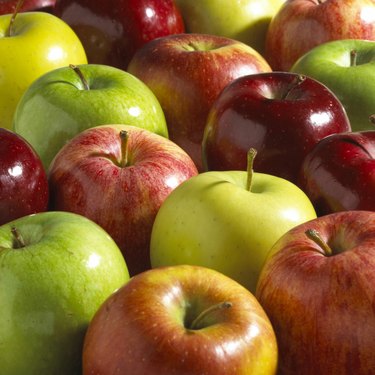 Organic in-season apples Image Credit: Purestock/Purestock/Getty Images
Organic in-season apples Image Credit: Purestock/Purestock/Getty Images
Start to Finish: 2 hours Servings: Variable Difficulty: Easy
Commercial apple-juice concentrate contains juice and ascorbic acid, ingredients readily available at the same supermarkets where you buy concentrate. Take advantage of the flexibility homemade concentrate affords and combine varieties for a tailored taste — you'll find the best apples at farmers markets in September and October. Peeling and coring apples before juicing is optional, but the skins and seeds contribute tannins that impart mild bitterness to the finished juice. Twenty pounds of apples produces about 1 gallon of juice and 1/3 gallon of concentrate. Although not required, a combination apple corer/peeler cuts the prep time down by half or more.
Ingredients
- Ascorbic acid
- Fine-mesh sieve
- Rubber spatula
- Cheesecloth
- Sugar (optional)
- Freezer-safe container or canning jars
Peeling and Pureeing
Add enough water to fill a food-grade container half full of water. Add 1/2 teaspoon of ascorbic acid per 1 gallon of water.
Peel, core and slice the apples. Discard any brown, bruised or blemished apple slices as you cut them. Add the apple slices to the water, and stir to coat them in the water mixture.
Pour 2 inches of water in a deep pot and add the apple slices. Set the apples on the stove over medium heat and cover the pot.
Simmer the apples until soft. Mash the apples using a potato masher, every 10 minutes. Expect about 15 minutes of cooking per 10 pounds of apples.
Set a fine-mesh sieve over a large food-grade container or a second pot. Scoop the cooked apples into the sieve, and press them through using a rubber spatula.
Strain the collected juice through a fine-mesh sieve lined with two to three layers of cheesecloth and into another pot or container. Stir in 1/2 teaspoon of ascorbic acid per 1 gallon of juice.
Sweeten the apple juice with sugar to taste, if desired. Simmer the apple juice until it reduces by about two-thirds. Take the pot off the stove, and stir the apple juice a few minutes to speed up its cooling.
Packing for Freezing
Place the jars or freezer-safe containers in the freezer while the apple juice cools. Chilled containers help the juice freeze faster.
Pour the apple-juice concentrate in the containers or jars when it cools to room temperature. Leave 1/2 inch of head-space at the top.
Place the apple juice in the freezer, leaving an inch or two on either side of the container. After the juice freezes, you can pack it alongside other foods.
Cooking Notes
Any apple that tastes good as a snack will taste good juiced. But you don't have to limit yourself to supermarket staples red delicious and Fuji. Braeburns, golden delicious and pink ladies — each on its own or combined — have a balance of tart and sweet that pleases any palate.
Ice cube trays make portioning juice concentrate easy. Instead of jars, pour the apple-juice concentrate in an ice cube tray and freeze it uncovered. After the concentrate freezes, pack the trays in a heavy-duty storage bag.
Don't toss the apple peels! Reserve peels for apple tea, jam and for cleaning aluminum cookware.


